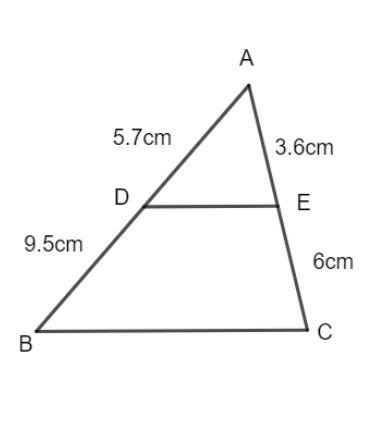Answer
416.7k+ views
Hint: AB and AC are intercepts on the lines BC and DE. If the intercepts are in the same ratio between the lines BC and DE, then by basic proportionality theorem, the lines BC and DE are parallel.
Complete step-by-step answer:
If a line is parallel to a side of a triangle that intersects the other sides of the triangle at two distinct points, then the line divides those sides of the triangle in proportion.
It is a basic result of the equal intercept theorem which states that if a transversal makes equal intercepts on three or more parallel lines then any other transversal cutting them will also make equal intercepts.
Now, we have triangle ABC, and the line DE intersects the sides AB and AC at D and E respectively.

We now find the ratio of AD and BD as follows:
\[\dfrac{{AD}}{{BD}} = \dfrac{{5.7}}{{9.5}}\]
Simplifying the above expression, we have:
\[\dfrac{{AD}}{{BD}} = \dfrac{3}{5}..........(1)\]
We now find the ratio of AE and CE as follows:
\[\dfrac{{AE}}{{CE}} = \dfrac{{3.6}}{6}\]
Simplifying the above expression, we have:
\[\dfrac{{AE}}{{CE}} = \dfrac{3}{5}........(2)\]
From equation (1) and equation (2), we have:
\[\dfrac{{AE}}{{CE}} = \dfrac{{AD}}{{BD}}\]
Hence, the sides are divided into equal ratios.
Hence, by proportionality theorem, DE is parallel to BC.
Hence, the correct answer is option (a).
Note: It is very vague from the given question, so, draw the diagram first and then it becomes easy to solve and determine the correct answer.
Complete step-by-step answer:
If a line is parallel to a side of a triangle that intersects the other sides of the triangle at two distinct points, then the line divides those sides of the triangle in proportion.
It is a basic result of the equal intercept theorem which states that if a transversal makes equal intercepts on three or more parallel lines then any other transversal cutting them will also make equal intercepts.
Now, we have triangle ABC, and the line DE intersects the sides AB and AC at D and E respectively.

We now find the ratio of AD and BD as follows:
\[\dfrac{{AD}}{{BD}} = \dfrac{{5.7}}{{9.5}}\]
Simplifying the above expression, we have:
\[\dfrac{{AD}}{{BD}} = \dfrac{3}{5}..........(1)\]
We now find the ratio of AE and CE as follows:
\[\dfrac{{AE}}{{CE}} = \dfrac{{3.6}}{6}\]
Simplifying the above expression, we have:
\[\dfrac{{AE}}{{CE}} = \dfrac{3}{5}........(2)\]
From equation (1) and equation (2), we have:
\[\dfrac{{AE}}{{CE}} = \dfrac{{AD}}{{BD}}\]
Hence, the sides are divided into equal ratios.
Hence, by proportionality theorem, DE is parallel to BC.
Hence, the correct answer is option (a).
Note: It is very vague from the given question, so, draw the diagram first and then it becomes easy to solve and determine the correct answer.
Recently Updated Pages
Three beakers labelled as A B and C each containing 25 mL of water were taken A small amount of NaOH anhydrous CuSO4 and NaCl were added to the beakers A B and C respectively It was observed that there was an increase in the temperature of the solutions contained in beakers A and B whereas in case of beaker C the temperature of the solution falls Which one of the following statements isarecorrect i In beakers A and B exothermic process has occurred ii In beakers A and B endothermic process has occurred iii In beaker C exothermic process has occurred iv In beaker C endothermic process has occurred

The branch of science which deals with nature and natural class 10 physics CBSE

The Equation xxx + 2 is Satisfied when x is Equal to Class 10 Maths

Define absolute refractive index of a medium

Find out what do the algal bloom and redtides sign class 10 biology CBSE

Prove that the function fleft x right xn is continuous class 12 maths CBSE

Trending doubts
Difference between Prokaryotic cell and Eukaryotic class 11 biology CBSE

Difference Between Plant Cell and Animal Cell

Change the following sentences into negative and interrogative class 10 english CBSE

Fill the blanks with the suitable prepositions 1 The class 9 english CBSE

How many crores make 10 million class 7 maths CBSE

How fast is 60 miles per hour in kilometres per ho class 10 maths CBSE

What organs are located on the left side of your body class 11 biology CBSE

Give 10 examples for herbs , shrubs , climbers , creepers

One Metric ton is equal to kg A 10000 B 1000 C 100 class 11 physics CBSE



